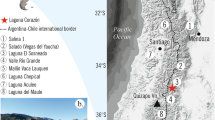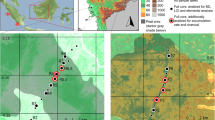Abstract
Paleosols buried under kurgans of the Early (2nd-1st centuries BC), Middle (1st-2nd centuries AD) and Late (2nd-IV centuries AD) Sarmatian epochs were studied in dry steppes and desert steppes of the Lower Volga region (the Privolzhskaya and Ergeni Uplands and the Caspian Lowland). It was found that temporal variations in the morphological, chemical, microbiological, and magnetic properties of the paleosols in the interval of 2200–1600 BP were characterized by the cyclic pattern related to secular dynamics of climatic humidity with changes in the mean annual precipitation of ±30–50 mm. These climate changes did not transform chestnut paleosols and paleosolonetzes at the type or subtype taxonomic levels. However, they led to certain changes in the humus, carbonate, and salt profiles of the soils; in the character of solonetzic horizon B1; and in the state of microbial communities. According to these data, the Sarmatian time was characterized by alternation of micropluvial and microarid stages lasting fro about 100–200 years. In particular, the stages of humidization were observed in the 1st century BC-1st century AD and in the 4th century AD; the most arid conditions were observed in the second half of the 2nd and the first half of the 3rd century AD.
Similar content being viewed by others
References
A. L. Aleksandrovskii and E. I. Aleksandrovskaya, Soil Evolution and the Geographic Environment (Nauka, Moscow, 2005) [in Russian].
Archaeological Encyclopaedia of Volgograd Oblast (Izd. VolGU, Volgograd, 2009) [in Russian].
A. V. Borisov, T. S. Demkina, and V. A. Demkin, Paleosols and Climate of the Ergeni Uplain in the Bronze Epoch (IV-II ka BC) (Nauka, Moscow, 2006) [in Russian].
A. V. Borisov, M. V. El’tsov, T. S. Demkina, et al., “Paleosols and Environmental Conditions of the Northern Ergeni Upland in the Sarmatian Epoch,” in Nizhnevolzh. Arkheol. Vestn. (Volgograd), No. 5, 117–125 (2002).
A. V. Vinogradov and E. D. Mamedov, “Changes in the Climate and Landscapes of the Amu Darya-Syr Darya Interfluve (according to Archaeological and Paleogeographic Data),” in The Aral Crisis (Moscow, 1991), pp. 66–75 [in Russian].
A. N. Gennadiev, Soils and Time: Models of Development (Izd. Mosk. Gos. Univ., Moscow, 1990) [in Russian].
V. A. Demkin, Paleopedology and Archaeology: Integration in Studying the History of Nature and Human Society (ONTI PNTs RAN, Pushchino, 1997) [in Russian].
V. A. Demkin, “Buried Soils of Defense Lines of Ancient Russia and the Problems of Ancient and Recent History of Soil Formation,” Pochvovedenie, No. 10, 1224–1234 (1999) [Eur. Soil Sci. 42 (10), 1094–1104 (1999)].
V. A. Demkin, L. A. Gugalinskaya, A. O. Alekseev, et al., Paleosols as Indicators of the Biosphere Evolution (NIA Priroda, Moscow, 2007) [in Russian].
V. A. Demkin, T. S. Demkina, A. O. Alekseev, et al., Paleosols and Climate of the Lower Volga Steppes in the 1st-4th Centuries AD (ONTI PNTs RAN, Pushchino, 2009) [in Russian].
V. A. Demkin, T. S. Demkina, A. V. Borisov, et al., “Izmenenie Transformation of Soils and Environmental Conditions in the Semidesert Low Volga Region within the Past 4000 Years,” Pochvovedenie, No. 3, 271–283 (2004) [Eur. Soil Sci. 37 (3), 230–241 (2004)].
V. A. Demkin, M. I. Dergacheva, A. V. Borisov, et al., “Soil Evolution and Climate Change in the Semidesert Zone of Eastern Europe during the Late Holocene,” Pochvovedenie, No. 2, 148–157 (1998) [Eur. Soil Sci. 31 (2), 133–143 (1998)].
V. A. Demkin, N. N. Kashirskaya, T. S. Demkina, et al., “Paleosol Studies of Burial Mounds in the Ilovlya River Valley (the Privolzhskaya Upland),” Pochvovedenie, No. 2, 133–145 (2008) [Eur. Soil Sci. 41 (2), 115–127 (2008)].
V. A. Demkin, I. V. Sergatskov, A. O. Alekseev, and M. V. El’tsov, “Paleosols of Burial Site Kolobovka-3 in Volgograd Oblast,” in Materials on Archaeology of Volga-Don Steppes (Izd. VolGU, Volgograd, 2001), No. 1, pp. 64–71 [in Russian].
T. S. Demkina, A. V. Borisov, and V. A. Demkin, “Microbial Communities in the Paleosols of Archaeological Monuments in the Desert-Steppe Zone,” Pochvovedenie, No. 9, 1117–1126 (2000) [Eur. Soil Sci. 33 (9), 978–986 (2000)].
T. S. Demkina, A. V. Borisov, and V. A. Demkin, “Microbiological Study of Paleosols Buried under Kurgans in the Desert-Steppe Zone of the Volga-Don Interfluve,” Pochvovedenie, No. 7, 853–859 (2004) [Eur. Soil Sci. 37 (7), 743–748 (2004)].
T. S. Demkina, T. E. Khomutova, N. N. Kashirskaya, et al., “Characteristics of Microbial Communities in Steppe Paleosols Buried under Kurgans of the Sarmatian Time (I-IV Centuries AD),” Pochvovedenie, No. 7, 836–846 (2009) [Eur. Soil Sci. 42 (7), 778–787 (2009)].
T. S. Demkina, T. E. Khomutova, N. N. Kashirskaya, et al., “Microbiological Investigations of Paleosols of Archeological Monuments in the Steppe Zone,” Pochvovedenie, No. 2, 213–220 (2010) [Eur. Soil Sci. 43 (2), 194–201 (2010)].
M. I. Dergacheva, Archaeological Soil Science (Sib. otd. Ross. Akad. Nauk, Novosibirsk, 1997) [in Russian].
Yu. M. Dmitruk, Zh. N. Matviishina, and I. I. Slyusarchuk, “Methodological Specificity of Soil Profile Morphometry in the Study of Zonal and Buried Soils,” in Climate Changes, Soils, and the Environment (Belgorod, 2009), pp. 30–34 [in Russian].
I. V. Ivanov, The Holocene Evolution of Soils in the Steppe Zone (Nauka, Moscow, 1992) [in Russian].
E. G. Maev, S. A. Maeva, and Yu. A. Karpychev, “The Aral Sea in the Holocene,” in Aral Crisis (Moscow, 1991), pp. 76–86 [in Russian].
D. S. Orlov, O. N. Biryukova, and N. I. Sukhanova, Organic Matter in Soils of the Russian Federation (Nauka, Moscow, 1996) [in Russian].
L. S. Pesochina, Extended Abstract of Candidate’s Dissertation in Biology (Moscow, 2004).
L. N. Plekhanova and V. A. Demkin, “Paleosols of Kurgans of the Early Iron Age in the Transural Steppe Zone,” Pochvovedenie, No. 1, 5–16 (2008) [Eur. Soil Sci. 41 (1), 1–12 (2008)].
Ya. G. Ryskov and V. A. Demkin, The Holocene Evolution of Soils and the Environment of Steppes in the Southern Urals (ONTI PNTs RAN, Pushchino, 1997) [in Russian].
A. S. Skripkin, History of Volgograd Region from the Stone Age to the Golden Horde Time (Izdatel’, Volgograd, 2008) [in Russian].
T. E. Khomutova, T. S. Demkina, and V. A. Demkin, “Assessment of the Total and Active Microbial Biomasses in Subkurgan Paleosols of Different Ages,” Mikrobiologiya 3(2), 241–247 (2004).
Y. Enzel, R. Bookman, D. Sharon, et al., “Late Holocene Climates of the Near East Deduced from Dead Sea Level Variations and Modern Winter Rainfall,” Quat. Res. 60, 263–273 (2003).
Author information
Authors and Affiliations
Corresponding author
Additional information
Original Russian Text © V.A. Demkin, B.N. Zolotareva, T.S. Demkina, T.E. Khomutova, N.N. Kashirskaya, M.V. El’tsov, S.N. Udal’tsov, 2012, published in Pochvovedenie, 2012, No. 2, pp. 142–155.
Rights and permissions
About this article
Cite this article
Demkin, V.A., Zolotareva, B.N., Demkina, T.S. et al. Dynamics of the properties of steppe paleosols of the Sarmatian time (2nd century BC-4th century AD) in relation to secular variations in climatic humidity. Eurasian Soil Sc. 45, 119–131 (2012). https://doi.org/10.1134/S106422931202007X
Received:
Published:
Issue Date:
DOI: https://doi.org/10.1134/S106422931202007X




